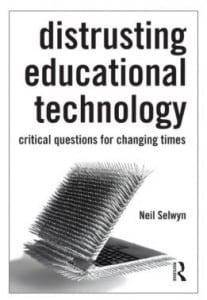Do you remember the great calculator debate? My trigonometry was learned with little books of Sine, Cosine and Tangent tables. It might have been the last century but it wasn’t that long ago. Did manual mental maths make me a better learner? No. It just used different parts of my brain. Progress through O and A levels was influenced by wider factors. My initial education was as socially divided and culturally defined as it is for millions of children today. One difference is the degree to which technology is now used for teaching and learning.
One of the books I took to #Bbworld2014 was Distrusting Educational Technology by Neil Selwyn. Travel is good for prolonged reading and Selwyn’s critical approach has always resonated. Calling on academics to question the perceived inevitability of technology, Selwyn writes how ET appears to do little to ‘…challenge or disrupt the prevailing reproduction of social inequalities that characterise contemporary education’ (2014: 164). In the book, four areas to distrust are virtual, social, open and gaming. On route to one of the biggest educational conferences in the world, presenting on e-teaching and ambivalent towards Blackboard, the chapter on distrusting the virtual seemed a good place to start…
…there wasn’t much good news.
Key issues in Chapter 3 Distrusting ‘Virtual’ Technologies in Education (pp 43-63) included the following:
- VLE are being used for governance and performance management with active surveillance being presented as helpful and benevolent. The panoptican of analytics fits well with Foucauldian views of discipline and self-regulation. It’s not difficult to see how monitoring student clicks reveals less about their learning ‘experience’ and more about strategic approaches to assessment. I liked the expression the ‘silences of VLE’ or what is not known because it can’t be seen or monitored – mainly the human aspects of education which technology has been been good at replicating 🙁 Another risk of analytics is highlighting norms and privileging them, which in turn reinforces the power of the designer to replicate majority expectations of behavior.
- VLE mostly replicate existing pedagogies rather than challenging or reinventing them. A reliance on transmission models privileges content production. Once resources are in place their delivery can be seen as something anyone can do which might raise questions about the need for qualified teachers in the first place.
- VLE also raise issues of status, not only lack of it for teaching online but the liminal nature of virtual environments and identities. Many times on TELEDA and in the research interviews, colleagues have said it was challenging to conceive the person behind the digital name. Nearly all described how the virtual was less privileged and easier to neglect during busy times. In terms of working with others, group members (and myself) were perceived as Un-Real or Other. Despite all best efforts, the virtual teaching space remained an artificial one. Lack of status is further reinforced by the absence of an agreed name for e-teachers. Tutors, trainers, faciliators, moderators, instructors but never e-lecturer.
One inevitable conclusion is maybe ET doesn’t have all the answers after all and early promises of transformation through VLE were lies!
Later in the book Selwyn cites Braverman* on deskilling, Machines were introduced into factories under the guise of being improvements for workers when the reality was loss of human labour. Braverman sits within a specifically Marxist approach and there is a problem with politics which fall into the trap of critique from a corner. For me, challenging ideology is best achieved through working alongside existing structures rather than in opposition to them. Investing academic effort into highlighting problems without offering practical solutions is not helpful.
Aside from this, Selwyn is always worth reading. He reminds you technology is never neutral but represents value laden sites of unequal power relationships. We’ve all been seduced into accepting technological progress as unquestioningly positive. So much so, even voices suggesting elearning has failed can only offer solutions within the paradigm promoting belief in the magic if we could just find the answer – like application of more rigorous theoretical approaches to content design and delivery*. Selwyn says those working with ET genuinely believe in its affordances. They are unable to see the underlying politics disguised as promises to cut costs, increase efficiency and choice, support diversity of access and produce self-directed learners. ET’s ideological foundations have to be revealed through critical thinking and reflection before we can see its shaping by dominant interests which seek perpetuation.
What’s the solution? Selwyn calls for bottom up approaches towards ET, giving voice to the marginalised and silenced, including those who teach and support learning. While technologists and managers make key ET decisions, the experience of day-to-day users often gets missed. TELEDA tries to bridge some of these divides by creating space for critical reflection but, understandably, most colleagues are focused on how to use ET to enhance the teaching of their subject and their students’ experience. While this is no reason to abandon the soapbox on digital exclusion and broader thinking around the adoption of ET, distrusting it seems likely to remain a minority occupation.

Braverman, H. (1974) Labor and Monopoly Capital: The Degradation of Work in the Twentieth Century. New York: Monthly Review Press.
Reeves, T. C., McKenny, S. and Herrington, J. (2010) Publishing and perishing: The critical importance of educational design research. Proceedings ASCILITE Sydney 2010.
Cartoon by Dave Walker. Find more cartoons you can freely re-use on your blog at We Blog Cartoons.

Comments are closed.